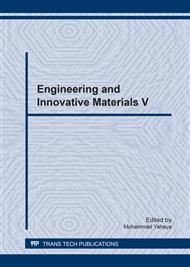[1]
S. Xu, A. J. Du, J. Liu, J. Ng, D. D. Sun, Highly efficient CuO incorporated TiO2 nanotube photocatalyst for hydrogen production from water, International Journal of Hydrogen Energy, Vol. 36 (2011), p.6560.
DOI: 10.1016/j.ijhydene.2011.02.103
Google Scholar
[2]
J. H. Huang, W. K. Ho, S. C. Lee Frank, Facile Synthesis of visible-light-activated F-doped TiO2 hollow spheres by ultrasonic spray pyrolysis, Science of Advanced Materials, Vol 4 (2012), p.863.
DOI: 10.1166/sam.2012.1358
Google Scholar
[3]
M. Pelaez, N. T. Nolan, S. C. Pillai, M. K. Seery, P. Falaras, A. G. Kontos, P. S. M. Dunlop, J. W. J. Hamilton, J. A. Byrne, K. O'Shea M. H. Entezari, D. D. Dionysiou, A review on the visible light active titanium dioxide photocatalysts for environmental applications, Applied Catalysis B: Environment, Vol. 125 (2012).
DOI: 10.1016/j.apcatb.2012.05.036
Google Scholar
[4]
M. H. Razali, A. F. Mohd Noor and M. Yusoff, Effect of calcination temperature on the physical properties and photocatalytic activity of TiO2 nanotubes synthesized by simple hydrothermal method, Australian Journal of Basic and Applied Sciences, Vol. 9 (2015).
Google Scholar
[5]
G. Wu, J. Wang, D. F. Thomas, A. Chen, Synthesis of F-doped flower-like TiO2 nanostructures with high photoelectrochemical activity, Langmuir, 24 (2008), p.3503.
DOI: 10.1021/la703098g
Google Scholar
[6]
G. Cao, Y. Li, Q. Zhang, H. Wang, Synthesis and characterization of La2O3/TiO2−xFx and the visible light photocatalytic oxidation of 4-chlorophenol, Journal of Hazardous Materials, Vol. 178 (2010), p.440.
DOI: 10.1016/j.jhazmat.2010.01.101
Google Scholar
[7]
S. Tosoni, D. F. Hevia, O. Diaz, F. Illas, Origin of optical excitations in fluorine-doped titania from response function theory: relevance to photocatalysis, Journals of Physical Chemistry Letters, Vol. 3 (2012), p.2269.
DOI: 10.1021/jz300870f
Google Scholar
[8]
L. Yang, P. Liu, X. Li, S. Li, The photo-catalytic activities of neodymium and fluorine doped TiO2 nanoparticles, Ceramics International, Vol 38 (2012), p.4791.
DOI: 10.1016/j.ceramint.2012.02.067
Google Scholar
[9]
C. Yu, Q. Fan, Y. Xie, J. Chen, Q. Shu, J. Yu, Sonochemical fabrication of novel square-shaped F doped TiO2 nanocrystals with enhanced performance in photocatalytic degradation of phenol, Journal of Hazardous Materials, Vol 237– 238 (2012), p.38.
DOI: 10.1016/j.jhazmat.2012.07.072
Google Scholar
[10]
V. Kumar, S. K. Sharma, T.P. Sharma, V. Singh, Band gap determination in thick films from reflectance measurements, Optical Materials, Vol. 12 (1999), p.115.
DOI: 10.1016/s0925-3467(98)00052-4
Google Scholar
[11]
S. Valencia, J. M. Marín, G. Restrepo, Study of the band gap of synthesized titanium dioxide nanoparticules using the sol-gel method and a hydrothermal treatment, The Open Materials Science Journal, Vol. 4 (2010), p.9.
DOI: 10.2174/1874088x01004010009
Google Scholar
[12]
Y. Wang, N. Herron: Nanometer-sized semiconductor clusters: materials synthesis, quantum size effects, and photophysical properties. J. Phys. Chem. Vol. 95 (1991), p.525.
DOI: 10.1021/j100155a009
Google Scholar
[13]
W. Ho, J. C. Yu, S. Lee, Synthesis of hierarchical nanoporous F-doped TiO2 spheres with visible light photocatalytic activity, Chemical Communication, Vol. 10 (2006), p.1115.
DOI: 10.1039/b515513d
Google Scholar
[14]
T. Yamaki, T. Umebayashi, T. Sumita, S. Yamamoto, M. Maekawa, A. Kawasuso, H. Itoh, Fluorine-doping in titanium dioxide by ion implantation technique, Nuclear Instruments and Methods in Physics Research Section B: Beam Interactions with Materials and Atoms, Vol. 206 (2003).
DOI: 10.1016/s0168-583x(03)00735-3
Google Scholar


